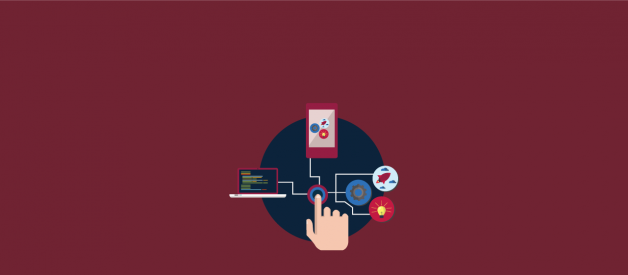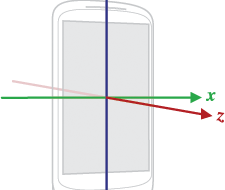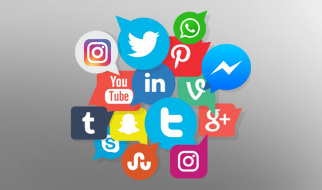Starbucks has the most regularly used loyalty rewards app among major restaurant chains. But what keeps users coming back for more? This case study will look at the design of the app, its features, and the bold moves that the coffee chain has made to make the app a ?must have? for consumers.

A recent study found that Starbucks has the most regularly used loyalty rewards app (48%) among a list of major restaurant chains. Why is the app so popular? What is it that keeps users coming back for more? The answer is digital engagement. From ordering and paying ahead of time to creating your own Spotify playlist, the Starbucks app provides a user experience that is both inviting and innovative, much like the coffee chain itself. That digital engagement has paid tremendous dividends for the company. At a JPMorgan forum in March, Starbucks CFO Scott Maw said almost all of the company?s same-store sales growth has come from customers that have digital relationships with the company and those that are in the Starbucks Rewards program. This case study will discuss four main reasons why the Starbucks app is a ?must have, must use? app for customers:
? User-friendly design? Engaging loyalty program? Mobile pay and ordering? Integration with other platforms and services
1. It Provides a User-Friendly Mobile Experience
The Starbucks app provides its users with a personalized experience. From highlighting what?s ?Now Playing? overhead in Starbucks stores, to personalized beverage and food offers, the content is highly relevant to customers. In the past two years, Starbucks added personalization elements that allow the app to recall your favorite order, suggest what food items might pair well with that order, and suggest where you?d like to pick it up. Using the geo-location feature, a user can see where the closest Starbucks locations are, the menu at each location, and even place an order that can be ready upon arrival.
Also, the app provides Starbucks Rewards program members with ?challenges? that can earn them additional ?stars? ? the chain?s name for its rewards points ? toward free food and beverages.
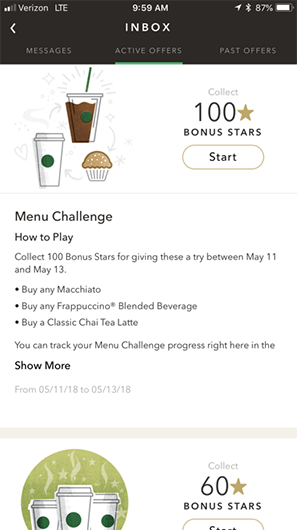
From featured food and beverage items to announcements for new products, Starbucks keeps its app users engaged and informed without seeming overbearing. Navigating through the app is quick and easy. Five menus at the top give the user access to the major functions: Pay, Stores, Gift, Order, and Music.

The layout is simple, yet elegant, making the app appealing to the user. The different menus ?pop-up? on the screen, giving the user easy navigation back to the home screen. One innovative feature of the Starbucks app is giving the user a similar experience to visiting the store. Many of us have stood in line at Starbucks thinking, ?I should get a gift card for (insert person/occasion).? The Gift menu brings up a variety of gift cards for nearly every occasion, and even suggests cards for upcoming holidays. Starbucks added the convenience functionality despite the risk of placing too many ?bells and whistles? in the app. Chief Digital Officer Adam Brotman acknowledged that the company didn?t ?want the app to become too much of a Swiss Army knife.?
However, the innovative features have been well received and have not overwhelmed users.
2. The Starbucks Rewards Loyalty Rewards Program Leads the Competition
The Starbucks Rewards program is a prime example of how to get customers to utilize a mobile app. Simply put, the more you spend at Starbucks, the more rewards points (or ?stars?) you earn.
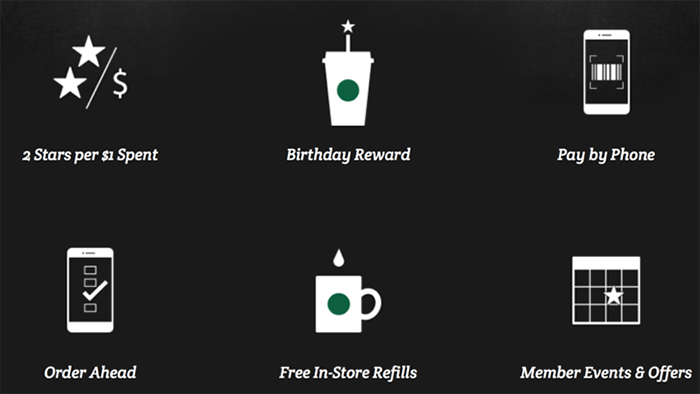
The rewards program gives a number of benefits for app users. In addition to earning two stars for every dollar spent, rewards members get other benefits like free in-store refills, special member offers/events, and the ability to pay by phone and order ahead.
The rewards program also offers plenty of customization for users, including a free beverage on the user?s birthday and personalized suggestions based upon past orders. In return, Starbucks solidifies an instant digital relationship with the 14.2 million active U.S. rewards program members. The loyalty program has seen hefty growth, with an 11% growth in users in Q2 2018. And Starbucks rewards program members in certain places actually spend more, representing 39% of the entire chain?s sales. However, Starbucks recognizes that not all customers want to join the rewards program. Starbucks is planning to ramp up digital interactions by offering mobile order and pay options to all customers ? not just rewards members. The company also will take advantage of Wi-Fi sign-ins at various stores to help drive mobile order and pay options. The Starbucks rewards program encourages users to utilize the app to track purchases, as well as the stars earned. To facilitate their usage, stars have a limited shelf life ? one year for basic (or ?Green?) level rewards customers, and six months for upper-tier (or ?Gold) members. The app provides reminders about stars that are expiring, as well as the number of stars needed to maintain Gold status. Gold members also get special double-star days when they earn four stars per $1 spent.
3. Starbucks? Mobile App Makes Online Ordering and Paying Easy
Since launching the initiatives in 2015, Starbucks has become the standard bearer when it comes to mobile ordering and payments. Mobile Order and Pay is a feature that let customers order via Starbucks? app and skip the line. At first, the growth of Mobile Order and Pay caused some congestion issues inside stores for customers while picking up their coffee and/or food. As one customer stated, ?Why should I order ahead if I just have to stand in line to retrieve my order??
Starbucks responded by adding dedicated stations for mobile order-ahead customers, distinct from existing in-store registers, and giving baristas new tablets. The mobile ordering system acts as a digital marketing tool, allowing customers to see new items ahead of time. Coupled with notifications from the app or email blasts, Starbucks creates interest in new menu items long before the customer sets foot in the store. Often, these digital tools create a sense of urgency for customers to sample the latest offerings. Starbucks also enabled orders via Amazon?s Alexa, and the feature has also been integrated into Ford vehicles. The coffee chain also expanded its My Starbucks barista, a feature integrated into the Starbucks app, which allows customers to order via voice command or messaging. The goal was to boost speed and convenience. In-store payments are also encouraged through the app, which utilizes a Starbucks gift card to process the payments. This creates seamless transactions, as the gift card can be automatically or manually reloaded using a credit card, Apple Pay or Google Pay, or even with the balance from another gift card. The app screen can be scanned at the register to process the payment. For iOS users, the app integrates with the Apple Watch, producing a bar code that also can be scanned for those on the go.
By offering a wide variety of functionalities, Starbucks? Mobile Order and Pay allows users to order and pay in the way that is most convenient for them ? which encourages greater sales.
4. Starbucks Integrates Its App With Other Platforms and Services
Music has long been an important part of the Starbucks brand and culture; in the past, the company gave away free tracks from iTunes to customers. Back in 2016, Starbucks and streaming service Spotify expanded their relationship with the launch of a new digital music experience for Starbucks customers. Starbucks worked with Spotify to enhance the app experience when it comes to music. The Starbucks app allows users to identify songs being played in stores, then download and save those they like to a playlist on Spotify?s app.
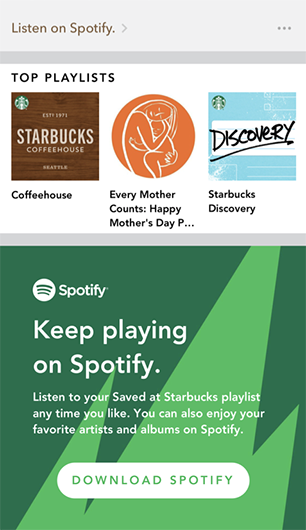
The feature ultimately boosts both Starbucks mobile app usage and sign-ups for Spotify?s music service. Another integration started in 2016, with Lyft handing out Starbucks loyalty program points to people who use the ride-sharing service.
Riders who connected their Starbucks Rewards account to their Lyft account would earn stars for each ride taken. First-time Lyft riders also earned enough stars for a free beverage for linking their accounts and taking a ride within a certain amount of time. Earlier this year, Starbucks and JP Morgan Chase began offering the Starbucks Rewards Visa Card, a co-branded credit card that integrated directly into the Starbucks Rewards? loyalty program. Customers using the card earn stars with every purchase both in and out of Starbucks stores wherever Visa is accepted worldwide.
These integrations increase Starbucks? customer engagement and help the app become more central to the user?s brand experience.
Starbucks? App Exemplifies Loyalty App Success
The Starbucks app is the center of the company?s digital ecosystem, bringing together loyalty, mobile payment, and content partnerships, all seamlessly integrated into one convenient application. Restaurants can follow Starbucks? example to create a successful restaurant loyalty rewards app.
This article was originally published on The Manifest on June 12, 2018, and was written by David Oragui.
